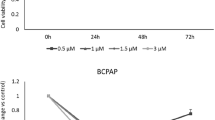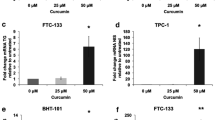Abstract
Ferulic acid (4-hydroxy-3-methoxycinnamic acid; FA), a common dietary plant phenolic compound, is abundant in fruits and vegetables. The aim of present study is to investigate the effects of FA on cell cycle, apoptosis, invasion, migration, and colony formation in the TT medullary thyroid cancer cell line. The effect of FA on cell viability was determined by using CellTiter-Glo assay. IC50 dose in the TT cells was detected as 150 μM. URG4/URGCP (upregulated gene-4/upregulator of cell proliferation) is a novel gene in full-length mRNA of 3.607 kb located on 7p13. It was determined that FA caused a decrease in the expression of novel gene URG4/URGCP, CCND1, CDK4, CDK6, BCL2, MMP2, and MMP9, a significant increase in the expression of p53, PARP, PUMA, NOXA, BAX, BID, CASP3, CASP9, and TIMP1 genes in TT human thyroid cancer cell line by using real-time PCR. It was found that FA in TT cells suppressed invasion, migration, and colony formation by using matrigel invasion chamber, wound healing, and colony formation assay, respectively. In conclusion, it is thought that FA indicates anticarcinogenesis activity by affecting cell cycle arrest, apoptosis, invasion, migration, and colony formation on TT cells.




Similar content being viewed by others
Abbreviations
- CCND1:
-
CyclinD1
- CTG:
-
CellTiter-Glo
- PARP:
-
Poly(ADP-ribose) polymerase
- URG4/URGCP :
-
Upregulated gene-4/upregulator of cell proliferation
- ECM:
-
Extracellular matrix
- MMP:
-
Matrix metalloproteinase
- MTC:
-
Medullary thyroid cancer
References
American Cancer Society. Cancer facts & figures. Atlanta, GA: The Society; 2015. p. 22.
Safavi A, Vijayasekaran A, Guerrero MA. New insight into the treatment of advanced differentiated thyroid cancer. J Thyroid Res. 2012;437569:8.
Brassard M, Rondeau G. Role of vandetanib in the management of medullary thyroid cancer. Biologics. 2012;6:59–66.
Schlumberger M, Carlomagno F, Baudin E, Bidart JM, Santoro M. New therapeutic approaches to treat medullary thyroid carcinoma. Nat ClinPract Endocrinol Metab. 2008;4(1):22–32.
Delellis RA. Pathology and genetics of thyroid carcinoma. J Surg Oncol. 2006;94(8):662–9.
Boikos SA, Stratakis CA. Molecular mechanisms of medullary thyroid carcinoma: current approaches in diagnosis and treatment. Histol Histopathol. 2008;23(1):109–16.
Corry DB, Kiss A, Song L, Xu J, Lee SH, Werb Z, et al. Overlapping and independent contributions of MMP2 and MMP9 to lung allergic inflammatory cell egression through decreased CC chemokines. FASEB J. 2004;18(9):995–7.
Davidson B, Reich R, Risberg B, Nesland JM. The biological role and regulation of matrix metalloproteinases (MMP) in cancer. Arkh Patol. 2002;64(3):47–53.
Han X, Shen T, Lou H. Dietary polyphenols and their biological significance. Int J Mol Sci. 2007;8:950–88.
Gonthier MP, Remesy C, Scalbert A, Cheynier V, Souquet JM, Poutanen K, et al. Microbial metabolism of caffeic acid and its esters chlorogenic and caftaric acids by human faecal microbiota in vitro. Biomed Pharmacother. 2006;60(9):536–40.
Hemaiswarya S, Doble M. Combination of phenylpropanoids with 5-fluorouracil as anti-cancer agents against human cervical cancer (HeLa) cell line. Phytomedicine. 2013;20(2):151–8.
Peng CC, Chyau CC, Wang HE, Chang CH, Chen KC, Chou KY and Peng RY. Cytotoxicity of Ferulic Acid on T24 Cell Line Differentiated by Different Microenvironments. BioMed Res Int. 2013; doi: 10.1155/2013/579859.
Carbone C, Campisi A, Musumeci T, Raciti G, Bonfanti R, Puglisi G. FA-loaded lipid drug delivery systems: preparation, characterization and biological studies. Eur J Pharm Sci. 2014;52:12–20.
Prasad NR, Srinivasan M, Pugalendi KV, Menon VP. Protective effect of ferulic acid on gamma radiation-induced micronuclei, dicentric aberration and lipid peroxidation in human lymphocytes. Mutat Res. 2006;603(2):129–34.
Tufan NL, Lian Z, Liu J, Pan J, Arbuthnot P, Kew M, et al. Hepatitis Bx antigen stimulates expression of a novel cellular gene, URG4, that promotes hepatocellular growth and survival. Neoplasia. 2002;4(4):355–68.
Song J, Xie H, Liany Z, Yang G, Du R, Du Y, et al. Enhanced cell survival of gastric cells by a novel gene URG4. Neoplasia. 2006;8(12):995–1002.
Huang J, Zhu B, Lu L, Lian Z, Wang Y, Yang X, et al. The expression of novel gene URG4 in osteosarcoma: correlation with patients’ prognosis. Pathology. 2009;41(2):149–54.
Dodurga Y, Oymak Y, Gündüz C, Tufan NL, Vergin C, Cetingul N, et al. Leukemogenesis as a new approach to investigate the correlation between up regulated gene 4/upregulator of cell proliferation (URG4/URGCP) and signal transduction genes in leukemia. Mol Biol Rep. 2013;40(4):3043–8.
HemaIswarya Sand Doble M. Potential synergism of natural products in the treatment of cancer. Phytother Res. 2006;20(4):239–49.
Kampa M, Alexaki VI, Notas G, Nifli AP, Nistikaki A, Hatzoglou A, et al. Antiproliferative and apoptotic effects of selective phenolic acids on T47D human breast cancer cells: potentialmechanisms of action. Breast Cancer Res. 2004;6(2):R63–74.
King PJ, Ma G, Miao W, Jia Q, McDougall BR, Reinecke MG, et al. Structure-activity relationships: analogues of the dicaffeoylquinic and dicaffeoyltartaric acids as potent inhibitors of human immunodeficiency virus type 1 integrase and replication. J Med Chem. 1999;42(3):497–509.
Lin LC, Kuo YC, Chou CJ. Immunomodulatory principles of Dichrocephala bicolor. J Nat Prod. 1999;62(3):405–8.
Karthikeyan S, Kanimozhi G, Prasad NR, Mahalakshmi R. Radiosensitizing effect of ferulic acid on human cervical carcinoma cells in vitro. Toxicol In Vitro. 2011;25(7):1366–75.
Hou Y, Yang J, Zhao G, Yuan Y. Ferulic acid inhibits endothelial cell proliferation through NO down-regulating ERK1/2 pathway. J Cell Biochem. 2004;93(6):1203–9.
Tan BL, Norhaizan ME, Yeap SK, Roselina K. Water extract of brewers' rice induces antiproliferation of human colorectal cancer (HT-29) cell lines via the induction of apoptosis. Eur Rev Med Pharmacol Sci. 2015;19(6):1022–9.
Eroğlu C, Seçme M, Bağcı G and Dodurga Y. Assessment of the anticancer mechanism of ferulic acid via cell cycle and apoptotic pathways in human prostate cancer cell lines. Tumor Biol. 2015; DOI: 10.1007/s13277-015-3689-3.
Çıtışlı V, Dodurga Y, Eroğlu C, Seçme M, Avcı ÇB and Şatıroğlu-Tufan NL.Temozolomide may induce cell cycle arrest by interacting with URG4/URGCP in SHSY5Y neuroblastoma cells. Tumor Biol. 2015; DOI: 10.1007/s13277-015-3373-7.
Satiroglu-Tufan NL, Dodurga Y, Gok D, Cetinkaya A, Feitelson MA. RNA interference-mediated URG4 gene silencing diminishes cyclin D1 mRNA expression in HepG2 cells. Genet Mol Res. 2010;9(3):1557–67.
Bandagula VR, Prasad NR. 2-Deoxy-glucose and ferulic acid modulates radiation response signaling in non-small cell lung cancer cells. Tumor Biol. 2013;34(1):251–9.
Meyer N, Kim SS, Penn LZ. The Oscar-worthy role of Myc in apoptosis. Semin Cancer Biol. 2006;16:275–87.
Li J, Yuan J. Caspases in apoptosis and beyond. Oncogene. 2008;27(48):6194–206.
Folgueras AR, Pendás AM, Sánchez LM, López-Otín C. Matrix metalloproteinases in cancer: from new functions to improved inhibition strategies. Int J Dev Biol. 2004;48(5–6):411–24.
Liang H, Zhong Y, Luo Z, Huang Y, Lin H, Zhan S, et al. Diagnostic value of 16 cellular tumor markers for metastatic thyroid cancer: an immunohistochemical study. Anticancer Res. 2011;31(10):3433–40.
Xing S, Zhang B, Hua R, Tai WC, Zeng Z, Xie B, et al. URG4/URGCP enhances the angiogenic capacity of human hepatocellular carcinoma cells in vitro via activation of the NF-κB signaling pathway. BMC Cancer. 2015;15:368.
Yuan Z, Zhang JP, Yang C. Study on the effects of ferulic acid on the vascular smooth muscle cell migration in vitro. Zhongguo Zhong Xi Yi Jie He ZaZhi. 2012;32(2):229–33.
Fang HY, Wang HM, Chang KF, Hu HT, Hwang LJ, Fu TF, et al. Feruloyl-L-arabinose attenuates migration, invasion and production of reactive oxygen species in H1299 lung cancer cells. Food Chem Toxicol. 2013;58:459–66.
Author information
Authors and Affiliations
Corresponding author
Rights and permissions
About this article
Cite this article
Dodurga, Y., Eroğlu, C., Seçme, M. et al. Anti-proliferative and anti-invasive effects of ferulic acid in TT medullary thyroid cancer cells interacting with URG4/URGCP . Tumor Biol. 37, 1933–1940 (2016). https://doi.org/10.1007/s13277-015-3984-z
Received:
Accepted:
Published:
Issue Date:
DOI: https://doi.org/10.1007/s13277-015-3984-z




